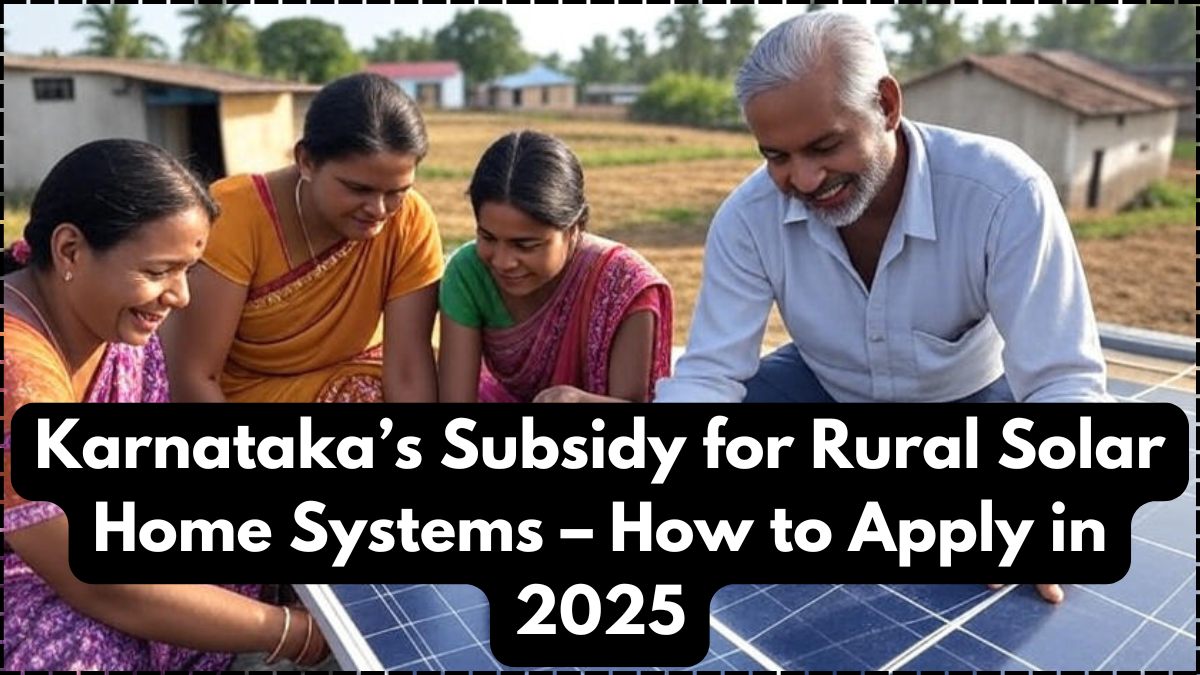With energy needs growing and rural connectivity still limited in many districts, the Karnataka solar subsidy 2025 program is emerging as a major success story. Focused on delivering reliable electricity to off-grid homes and promoting renewable energy, the scheme targets villages and semi-urban belts with a mix of subsidies, technical support, and installation benefits.
Run by the Karnataka Renewable Energy Development Limited (KREDL), this initiative under the state’s rural solar scheme Karnataka has already impacted thousands of families by cutting their dependency on diesel generators and unstable grid power. In 2025, the scheme has expanded to cover more regions, offer bigger subsidies, and allow easier online applications.
Here’s everything you need to know about how the program works, who can apply, and how it benefits both citizens and the state’s green energy goals.

Why Karnataka’s Rural Solar Scheme Is Gaining Attention
Karnataka is among India’s leaders in clean energy, but rural homes in remote areas still face frequent power cuts and limited access to electricity. The Karnataka solar subsidy 2025 targets these energy gaps using solar kits that can power lights, fans, TVs, and mobile charging units.
Reasons why the rural solar scheme Karnataka has become a state priority:
-
Rural electrification gap in tribal and forest-border areas
-
Push for renewable energy under India’s national solar mission
-
Increased fuel costs for generators in low-income households
-
Need for climate-resilient power sources due to erratic monsoons
-
Job creation through local solar installation teams
With solar home systems now more affordable and efficient, the scheme aligns both economic and environmental priorities.
Key Benefits of the Karnataka Solar Subsidy 2025
The Karnataka solar subsidy 2025 offers a range of financial and technical benefits designed to make solar power practical for rural families. Here are the major features of the program:
-
Subsidy coverage of up to 70% on verified home solar kits
-
System types supported: 200W to 1kW setups depending on household size
-
Installation support through state-certified vendors
-
3-year maintenance warranty included with approved kits
-
Battery backup for night-time use or cloudy weather
-
Online application and tracking portal for faster processing
Let’s take a look at how the benefits compare based on the type of installation:
System Size |
Ideal Use Case |
Total Cost |
Subsidy Provided |
Final Cost to User |
|---|---|---|---|---|
200W System |
1–2 LED lights + phone charging |
₹18,000 |
₹12,600 (70%) |
₹5,400 |
500W System |
Lights + fan + mobile charging |
₹38,000 |
₹26,600 (70%) |
₹11,400 |
1kW System |
Lights + fan + TV + small pump |
₹70,000 |
₹49,000 (70%) |
₹21,000 |
The rural solar scheme Karnataka ensures that even low-income families can access clean, safe energy with minimum upfront expense.
How to Apply for the Karnataka Solar Subsidy in 2025
The application process for the Karnataka solar subsidy 2025 has now gone fully digital to improve access and speed. Interested families or individuals can follow a streamlined step-by-step process:
-
Visit the official KREDL portal (available in Kannada and English)
-
Register using Aadhaar and mobile number
-
Upload proof of residence, income certificate, and electricity bill (if any)
-
Choose the system size and vendor from the approved list
-
Submit the application and receive tracking ID
-
Wait for technical verification visit and approval
-
Installation within 30–45 days after subsidy approval
The rural solar scheme Karnataka also deploys field officers to help with offline form assistance in especially remote areas.
Long-Term Impact on Rural Development
The Karnataka solar subsidy 2025 is not just about energy—it’s a development tool. By providing consistent electricity, it enables rural children to study at night, women to use home appliances safely, and families to reduce dependency on harmful kerosene lamps.
Key impacts observed so far:
-
Improved education outcomes due to night-time lighting
-
Boost in rural businesses like tailoring, welding, and small shops
-
Reduced respiratory issues from kerosene smoke
-
Environmental impact: thousands of tons of CO₂ emissions avoided
-
Better access to information with phone charging and TV use
The rural solar scheme Karnataka continues to evolve with partnerships from NGOs, startups, and CSR funds that help bridge local awareness gaps.
Conclusion
The Karnataka solar subsidy 2025 stands out as a model for effective rural electrification in India. By removing cost barriers and offering reliable, clean energy, it’s lighting up homes and futures across the state. For those living off the grid or facing unreliable power, the rural solar scheme Karnataka is a golden opportunity to switch to solar and join the clean energy movement. With simplified applications, strong technical support, and long-term impact, this initiative shows what good governance in the energy sector looks like.
FAQs
Who is eligible for Karnataka solar subsidy 2025?
Any resident of Karnataka living in a rural or semi-rural area without reliable electricity supply is eligible. Income-based priority may apply.
How much financial support is available under the scheme?
The government covers up to 70% of the system cost under the Karnataka solar subsidy 2025, depending on the size of the solar unit.
What appliances can a 500W system support?
A 500W system can run LED lights, a ceiling fan, phone charging points, and possibly a small radio or router.
Can farmers use this scheme for agricultural pumps?
No, the rural solar scheme Karnataka is for household solar needs. A separate subsidy exists under the PM-KUSUM scheme for solar water pumps.
Click here to learn more